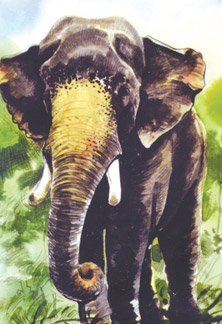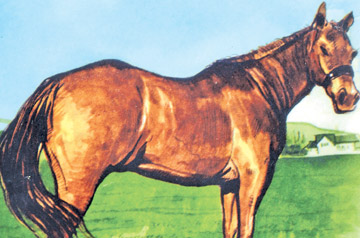Splendour and uncertainty of Wild Life
K A Aleem - Gampola Thinkaran Correspondent
 Animals live in a world that is older and certainly more complete
than ours. They are gifted with extensions of the senses we have lost or
never really attained. They are more reliable than most people. Many are
capable of great and lasting love, true gratitude and unstinting
loyalty-rather difficult standards for people to live up to. Humans and
animals have one thing in common though: Both species are caught in the
net of life, as fellow prisoners of both the splendour and the
uncertainty of their coexistence. Animals live in a world that is older and certainly more complete
than ours. They are gifted with extensions of the senses we have lost or
never really attained. They are more reliable than most people. Many are
capable of great and lasting love, true gratitude and unstinting
loyalty-rather difficult standards for people to live up to. Humans and
animals have one thing in common though: Both species are caught in the
net of life, as fellow prisoners of both the splendour and the
uncertainty of their coexistence.
The cape buffalo
The Cape Buffalo weighs some 550 lbs on average and is equipped with
a magnificent spread of horns, fused at the base to form a hone wall
that been bullets cannot penetrate. The males protect the herd, which
lives by a community code. They stick close together, the calves and
other half-growns in the centre and the formidable males on the outer
circles. This forces been foraging lions to keep their distance. At face
value, it would seen that these animals are safer and better taken care
of than many of us humans. A year to emulate these animals perhaps?
The horse
 The horse as we know it is the result of 40 million years of
evolution. Highly intelligent, this high-spirited animals is also very
affectionate and tractable. It is endowed with a perfect sense of
balance: A fine – tuned ‘fight or flight’ instinct. A magnificent sight
in fight, the horse also has a streak of the indomitable and will, if
the need arises, fight to the bitter end. A mix of sterling qualities:
Courage and a touch of aggression tempered by gentleness. All worth
imitating. The horse as we know it is the result of 40 million years of
evolution. Highly intelligent, this high-spirited animals is also very
affectionate and tractable. It is endowed with a perfect sense of
balance: A fine – tuned ‘fight or flight’ instinct. A magnificent sight
in fight, the horse also has a streak of the indomitable and will, if
the need arises, fight to the bitter end. A mix of sterling qualities:
Courage and a touch of aggression tempered by gentleness. All worth
imitating.
The blue whale
Carl Linnaeus, the Swedish Zoologist, must have had a wicked sense of
humour. He named the earth’s largest animal’ which is as big as a Boeing
jet and has heart the size of a small car, Balaenoptera musculus:
“Little Mouse.” The blue whale usually grows up to 10 feet and weights
180 metric tons-on the average. It feeds on a species of shrimp named
krill and plankton like euphausids only. This massive mammal does not
terrorize the ocean’s other denizes – but serves as an example wroth
emulating, where might is not regarded as right.
The chimpanzee
Anthropologists and zoologists agree on one thing: Champanzees are
the mammals closest to humans in behaviour: Noisy, curious, inventive,
intelligent and social. To eat termites and insects, for instance, it
goes typically human by not working at tearing the mound down – the
chimp simply pushes as stick in and then eats the insects that cling to
it! The females give all the young, not just their own, the same care
and attention. AS a rule, chimpanzees also care for the elderly, who in
turn are extremely patient with the hyperenergetic youngsters. No
elder’s Homes or Children’s Homes in the chimpanzee’s world – just a lot
of love going around. Something to think about.
The elephant
 The elephant today, is the end-product of seven million years of
evolution. The African and Asian elephants vary in size, but on average,
an elephant stands nine feet at the shoulder and tips the scale sat
around 8,000 lbs. The elephant has for centuries been symbolic of wisdom
because of a degree of intelligence higher than most animals and a long
memory. The incredible strength that is tempered with surprising
gentleness – until provoked – serves as an ideal example of tolerance
for us. Overall, the elephant earned high praise from the Greek
philosopher Aristotle. The elephant today, is the end-product of seven million years of
evolution. The African and Asian elephants vary in size, but on average,
an elephant stands nine feet at the shoulder and tips the scale sat
around 8,000 lbs. The elephant has for centuries been symbolic of wisdom
because of a degree of intelligence higher than most animals and a long
memory. The incredible strength that is tempered with surprising
gentleness – until provoked – serves as an ideal example of tolerance
for us. Overall, the elephant earned high praise from the Greek
philosopher Aristotle.
The stingray
The stingray has its eyes on the top of its head and its mouth,
nostrils and gill slits are situated on its underbelly. The stingray
swims by undulations of it is flat body. Its prime feature is its tail
with serrated edges that end in a sharp point an contains venom in a
quantity, fatal even to humans. This deadly, poison-filled barb however,
is used only in self defense. Deterrents as powerful as an aggressor’s,
often suffice to make peaceful co-existence the preferred alternative.
The owl
Natue’s grand design has endowed the owl with fourteen vertebrae
bones in its neck twice as many as humans – which enables it to turn its
head as much as 270 degrees! This was, in all probability, the reason
for its being regarded as ‘wise’ as this physical attribute made the owl
more aware of everything happening around it. We lack this physical
attribute, but we can, with some help from technology, gain clearer
insights on just about everything.
The beaver
 The beaver is a semi-aquatic, nocturnal member of the rodent family –
in fact, the second largest – with penchant for building dams, canals
and its own home which is called as lodge. The beaver’s reserves of
food, wood and water for the winter are regularly replenished from
around autumn. The lessons for us humans? Early preparation for the
future to counter foreseeable events and reserves to fall back on in an
emergency. The beaver is a semi-aquatic, nocturnal member of the rodent family –
in fact, the second largest – with penchant for building dams, canals
and its own home which is called as lodge. The beaver’s reserves of
food, wood and water for the winter are regularly replenished from
around autumn. The lessons for us humans? Early preparation for the
future to counter foreseeable events and reserves to fall back on in an
emergency.
The lion
The lion is the second largest feline after the tiger. Equipped with
powerful legs and incredibly strong jaws, the lion can successfully prey
on large mammals. That trait however, did not earn it the tag “King of
the Jungle.” The title originated from the very majesty of the lion’s
mien or personality that commands respect. Yet, the king’s’ work hours
are only when it is hungry. Once sated, the lion co-exists with its
prey. Food for thought for us humans. |







